Fast Food Advertising: An Argumentative Research Essay
VerifiedAdded on 2023/01/16
|6
|1520
|21
Essay
AI Summary
This essay, written for ENGL 103, critically examines the ethics of fast food advertising and its impact on consumer health. The author argues that the promotion of fast food should be banned due to its deceptive nature and negative effects on the body. The essay delves into the unethical practices employed in fast food advertising, such as the use of misleading testimonials, false promises, and visual distortions, which exploit consumers. It highlights the health risks associated with high consumption of fast food, including increased risks of diabetes, obesity, and depression. The essay also references the impact of fast food on oral health and the potential disruption of hormonal balance due to the presence of chemicals. The author concludes that to protect consumers from the detrimental effects of fast food, the promotion of these products through advertising should be prohibited. The essay uses research to support its claims, making it a well-reasoned argument against the current practices of fast food advertising.
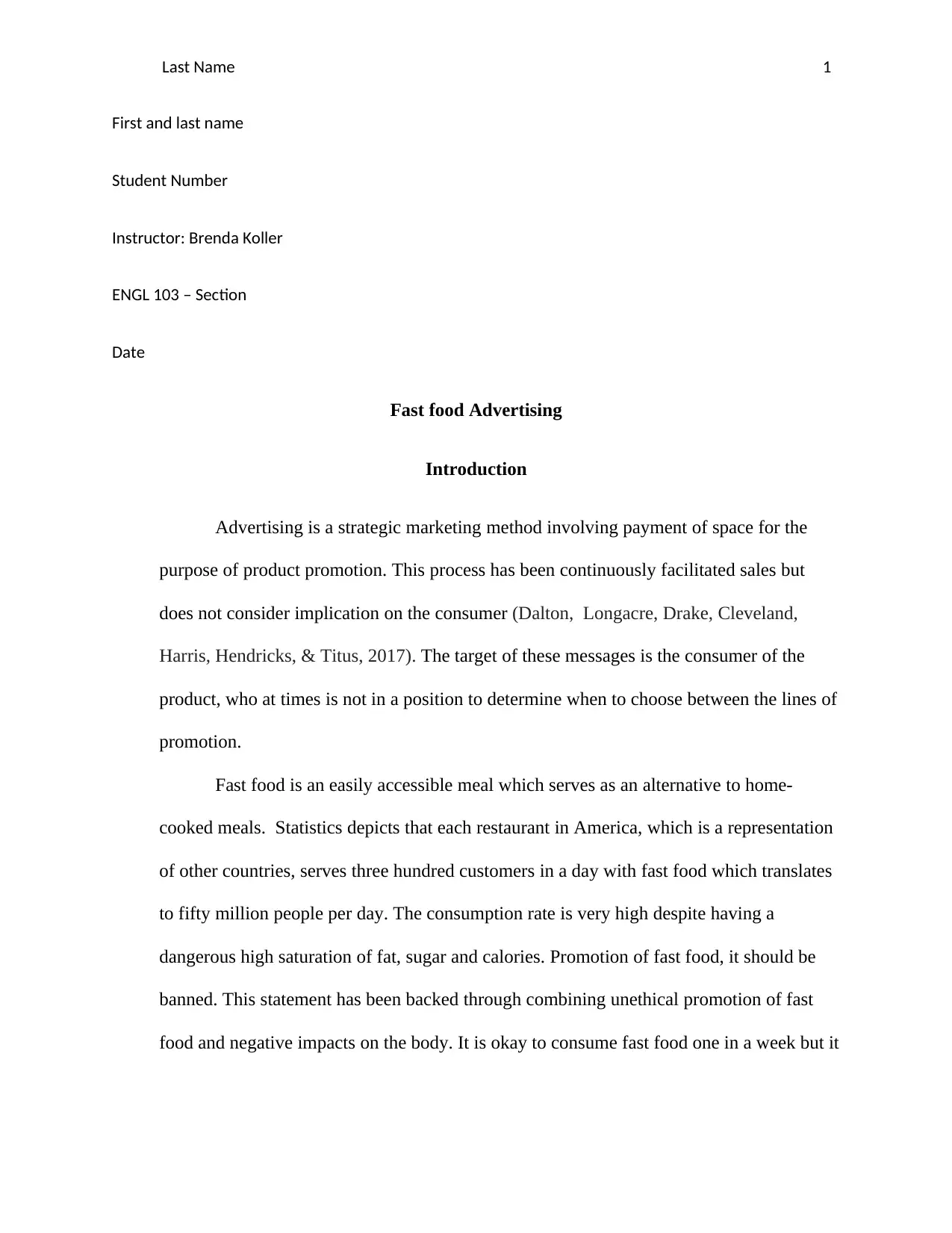
Last Name 1
First and last name
Student Number
Instructor: Brenda Koller
ENGL 103 – Section
Date
Fast food Advertising
Introduction
Advertising is a strategic marketing method involving payment of space for the
purpose of product promotion. This process has been continuously facilitated sales but
does not consider implication on the consumer (Dalton, Longacre, Drake, Cleveland,
Harris, Hendricks, & Titus, 2017). The target of these messages is the consumer of the
product, who at times is not in a position to determine when to choose between the lines of
promotion.
Fast food is an easily accessible meal which serves as an alternative to home-
cooked meals. Statistics depicts that each restaurant in America, which is a representation
of other countries, serves three hundred customers in a day with fast food which translates
to fifty million people per day. The consumption rate is very high despite having a
dangerous high saturation of fat, sugar and calories. Promotion of fast food, it should be
banned. This statement has been backed through combining unethical promotion of fast
food and negative impacts on the body. It is okay to consume fast food one in a week but it
First and last name
Student Number
Instructor: Brenda Koller
ENGL 103 – Section
Date
Fast food Advertising
Introduction
Advertising is a strategic marketing method involving payment of space for the
purpose of product promotion. This process has been continuously facilitated sales but
does not consider implication on the consumer (Dalton, Longacre, Drake, Cleveland,
Harris, Hendricks, & Titus, 2017). The target of these messages is the consumer of the
product, who at times is not in a position to determine when to choose between the lines of
promotion.
Fast food is an easily accessible meal which serves as an alternative to home-
cooked meals. Statistics depicts that each restaurant in America, which is a representation
of other countries, serves three hundred customers in a day with fast food which translates
to fifty million people per day. The consumption rate is very high despite having a
dangerous high saturation of fat, sugar and calories. Promotion of fast food, it should be
banned. This statement has been backed through combining unethical promotion of fast
food and negative impacts on the body. It is okay to consume fast food one in a week but it
Paraphrase This Document
Need a fresh take? Get an instant paraphrase of this document with our AI Paraphraser
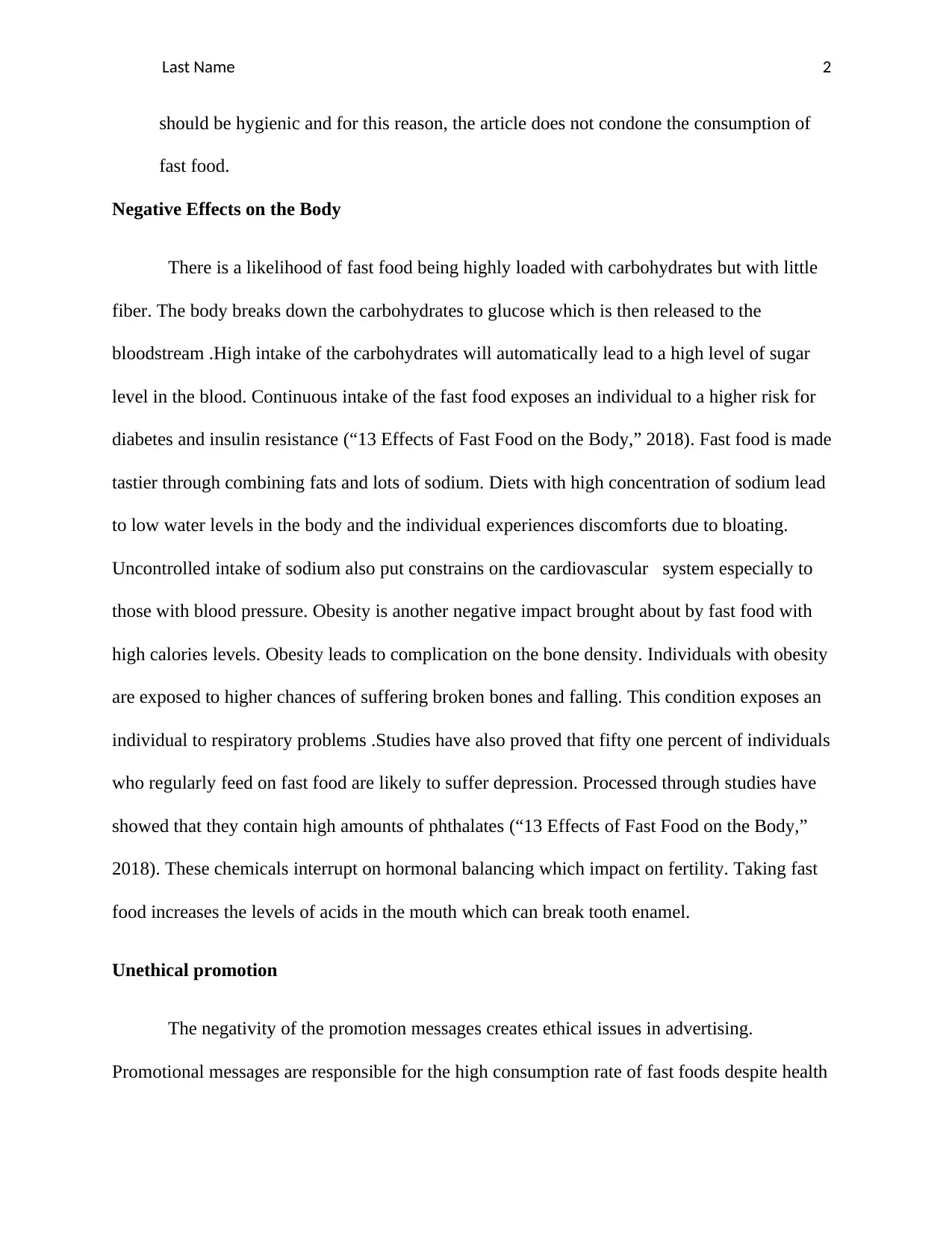
Last Name 2
should be hygienic and for this reason, the article does not condone the consumption of
fast food.
Negative Effects on the Body
There is a likelihood of fast food being highly loaded with carbohydrates but with little
fiber. The body breaks down the carbohydrates to glucose which is then released to the
bloodstream .High intake of the carbohydrates will automatically lead to a high level of sugar
level in the blood. Continuous intake of the fast food exposes an individual to a higher risk for
diabetes and insulin resistance (“13 Effects of Fast Food on the Body,” 2018). Fast food is made
tastier through combining fats and lots of sodium. Diets with high concentration of sodium lead
to low water levels in the body and the individual experiences discomforts due to bloating.
Uncontrolled intake of sodium also put constrains on the cardiovascular system especially to
those with blood pressure. Obesity is another negative impact brought about by fast food with
high calories levels. Obesity leads to complication on the bone density. Individuals with obesity
are exposed to higher chances of suffering broken bones and falling. This condition exposes an
individual to respiratory problems .Studies have also proved that fifty one percent of individuals
who regularly feed on fast food are likely to suffer depression. Processed through studies have
showed that they contain high amounts of phthalates (“13 Effects of Fast Food on the Body,”
2018). These chemicals interrupt on hormonal balancing which impact on fertility. Taking fast
food increases the levels of acids in the mouth which can break tooth enamel.
Unethical promotion
The negativity of the promotion messages creates ethical issues in advertising.
Promotional messages are responsible for the high consumption rate of fast foods despite health
should be hygienic and for this reason, the article does not condone the consumption of
fast food.
Negative Effects on the Body
There is a likelihood of fast food being highly loaded with carbohydrates but with little
fiber. The body breaks down the carbohydrates to glucose which is then released to the
bloodstream .High intake of the carbohydrates will automatically lead to a high level of sugar
level in the blood. Continuous intake of the fast food exposes an individual to a higher risk for
diabetes and insulin resistance (“13 Effects of Fast Food on the Body,” 2018). Fast food is made
tastier through combining fats and lots of sodium. Diets with high concentration of sodium lead
to low water levels in the body and the individual experiences discomforts due to bloating.
Uncontrolled intake of sodium also put constrains on the cardiovascular system especially to
those with blood pressure. Obesity is another negative impact brought about by fast food with
high calories levels. Obesity leads to complication on the bone density. Individuals with obesity
are exposed to higher chances of suffering broken bones and falling. This condition exposes an
individual to respiratory problems .Studies have also proved that fifty one percent of individuals
who regularly feed on fast food are likely to suffer depression. Processed through studies have
showed that they contain high amounts of phthalates (“13 Effects of Fast Food on the Body,”
2018). These chemicals interrupt on hormonal balancing which impact on fertility. Taking fast
food increases the levels of acids in the mouth which can break tooth enamel.
Unethical promotion
The negativity of the promotion messages creates ethical issues in advertising.
Promotional messages are responsible for the high consumption rate of fast foods despite health
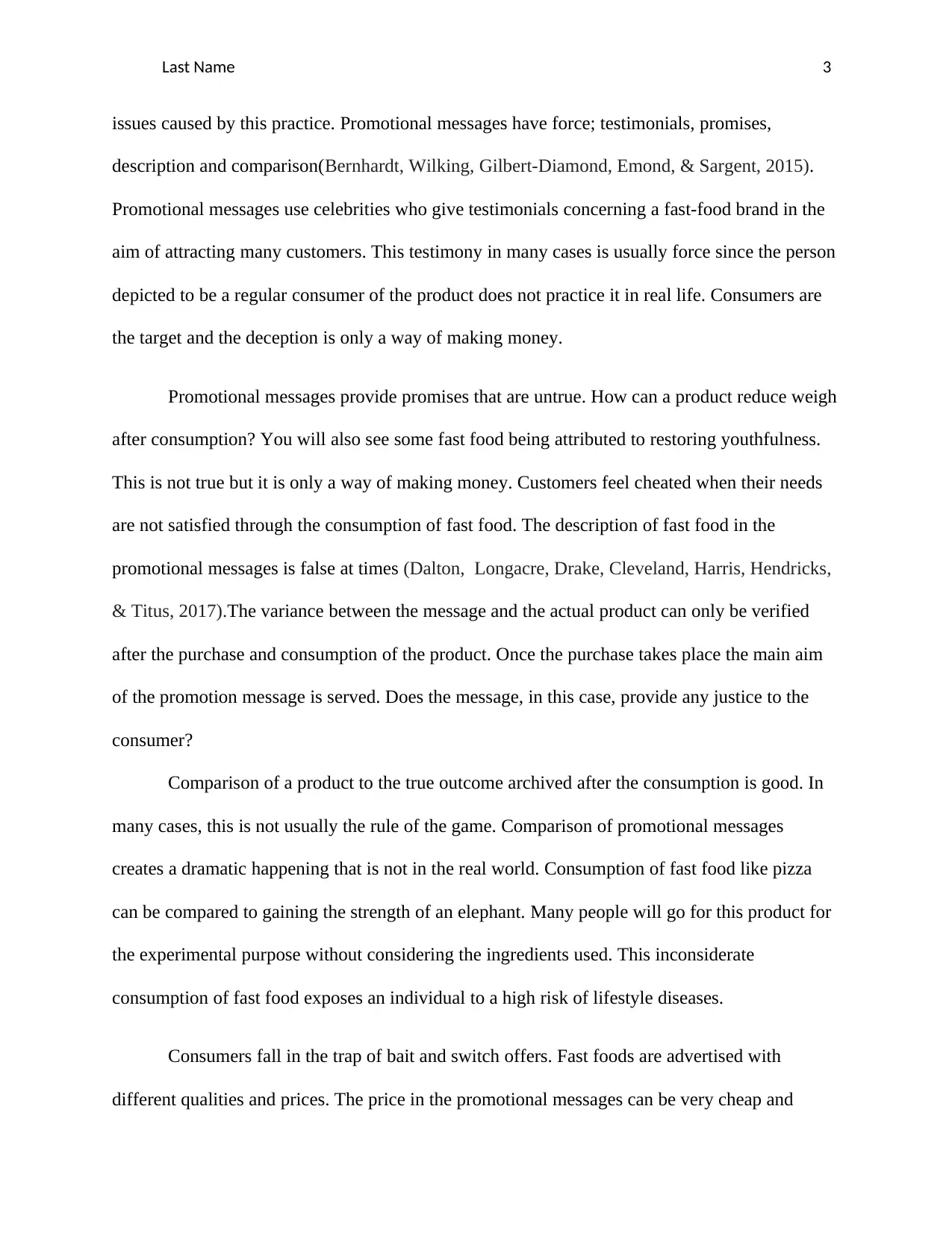
Last Name 3
issues caused by this practice. Promotional messages have force; testimonials, promises,
description and comparison(Bernhardt, Wilking, Gilbert-Diamond, Emond, & Sargent, 2015).
Promotional messages use celebrities who give testimonials concerning a fast-food brand in the
aim of attracting many customers. This testimony in many cases is usually force since the person
depicted to be a regular consumer of the product does not practice it in real life. Consumers are
the target and the deception is only a way of making money.
Promotional messages provide promises that are untrue. How can a product reduce weigh
after consumption? You will also see some fast food being attributed to restoring youthfulness.
This is not true but it is only a way of making money. Customers feel cheated when their needs
are not satisfied through the consumption of fast food. The description of fast food in the
promotional messages is false at times (Dalton, Longacre, Drake, Cleveland, Harris, Hendricks,
& Titus, 2017).The variance between the message and the actual product can only be verified
after the purchase and consumption of the product. Once the purchase takes place the main aim
of the promotion message is served. Does the message, in this case, provide any justice to the
consumer?
Comparison of a product to the true outcome archived after the consumption is good. In
many cases, this is not usually the rule of the game. Comparison of promotional messages
creates a dramatic happening that is not in the real world. Consumption of fast food like pizza
can be compared to gaining the strength of an elephant. Many people will go for this product for
the experimental purpose without considering the ingredients used. This inconsiderate
consumption of fast food exposes an individual to a high risk of lifestyle diseases.
Consumers fall in the trap of bait and switch offers. Fast foods are advertised with
different qualities and prices. The price in the promotional messages can be very cheap and
issues caused by this practice. Promotional messages have force; testimonials, promises,
description and comparison(Bernhardt, Wilking, Gilbert-Diamond, Emond, & Sargent, 2015).
Promotional messages use celebrities who give testimonials concerning a fast-food brand in the
aim of attracting many customers. This testimony in many cases is usually force since the person
depicted to be a regular consumer of the product does not practice it in real life. Consumers are
the target and the deception is only a way of making money.
Promotional messages provide promises that are untrue. How can a product reduce weigh
after consumption? You will also see some fast food being attributed to restoring youthfulness.
This is not true but it is only a way of making money. Customers feel cheated when their needs
are not satisfied through the consumption of fast food. The description of fast food in the
promotional messages is false at times (Dalton, Longacre, Drake, Cleveland, Harris, Hendricks,
& Titus, 2017).The variance between the message and the actual product can only be verified
after the purchase and consumption of the product. Once the purchase takes place the main aim
of the promotion message is served. Does the message, in this case, provide any justice to the
consumer?
Comparison of a product to the true outcome archived after the consumption is good. In
many cases, this is not usually the rule of the game. Comparison of promotional messages
creates a dramatic happening that is not in the real world. Consumption of fast food like pizza
can be compared to gaining the strength of an elephant. Many people will go for this product for
the experimental purpose without considering the ingredients used. This inconsiderate
consumption of fast food exposes an individual to a high risk of lifestyle diseases.
Consumers fall in the trap of bait and switch offers. Fast foods are advertised with
different qualities and prices. The price in the promotional messages can be very cheap and
⊘ This is a preview!⊘
Do you want full access?
Subscribe today to unlock all pages.

Trusted by 1+ million students worldwide
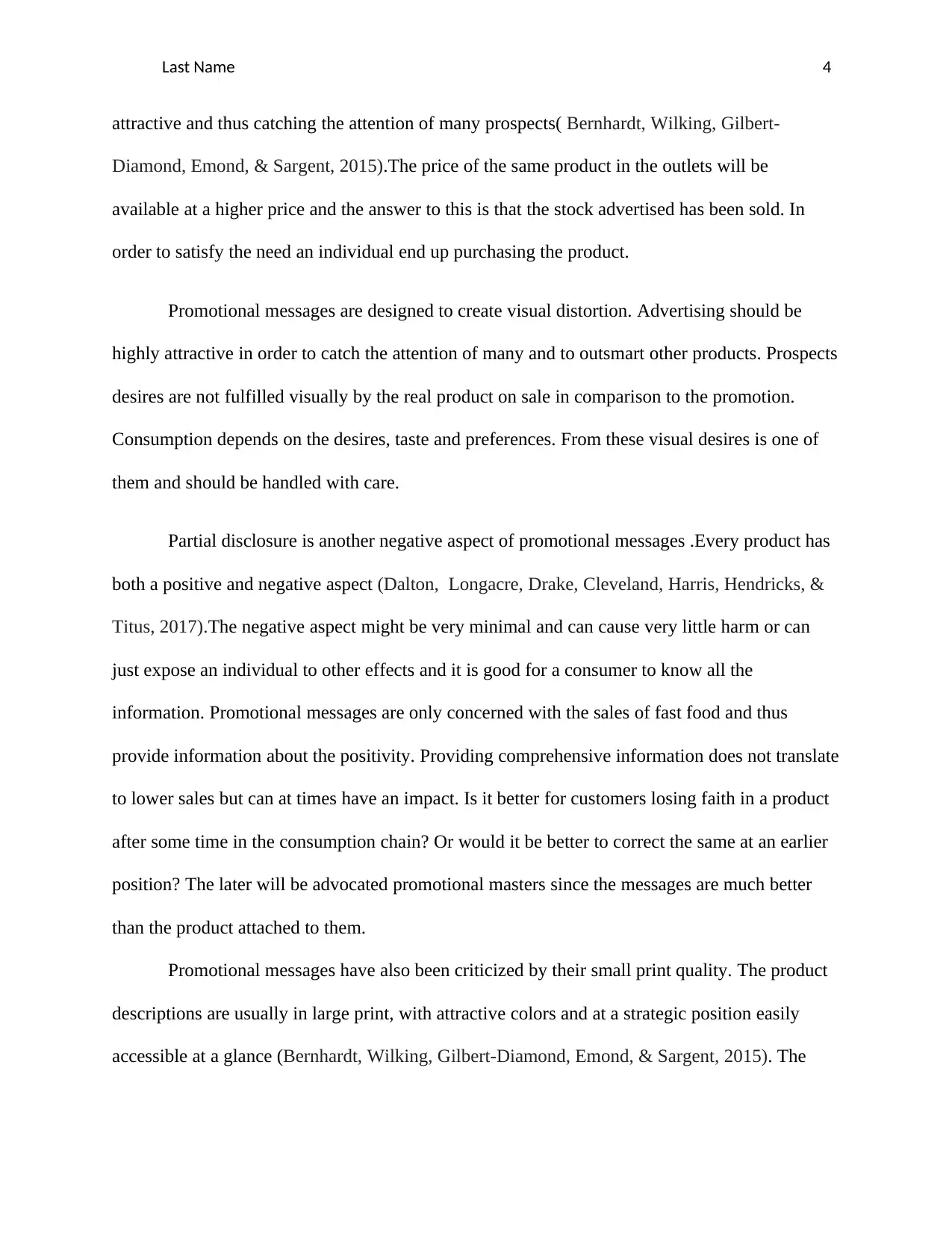
Last Name 4
attractive and thus catching the attention of many prospects( Bernhardt, Wilking, Gilbert-
Diamond, Emond, & Sargent, 2015).The price of the same product in the outlets will be
available at a higher price and the answer to this is that the stock advertised has been sold. In
order to satisfy the need an individual end up purchasing the product.
Promotional messages are designed to create visual distortion. Advertising should be
highly attractive in order to catch the attention of many and to outsmart other products. Prospects
desires are not fulfilled visually by the real product on sale in comparison to the promotion.
Consumption depends on the desires, taste and preferences. From these visual desires is one of
them and should be handled with care.
Partial disclosure is another negative aspect of promotional messages .Every product has
both a positive and negative aspect (Dalton, Longacre, Drake, Cleveland, Harris, Hendricks, &
Titus, 2017).The negative aspect might be very minimal and can cause very little harm or can
just expose an individual to other effects and it is good for a consumer to know all the
information. Promotional messages are only concerned with the sales of fast food and thus
provide information about the positivity. Providing comprehensive information does not translate
to lower sales but can at times have an impact. Is it better for customers losing faith in a product
after some time in the consumption chain? Or would it be better to correct the same at an earlier
position? The later will be advocated promotional masters since the messages are much better
than the product attached to them.
Promotional messages have also been criticized by their small print quality. The product
descriptions are usually in large print, with attractive colors and at a strategic position easily
accessible at a glance (Bernhardt, Wilking, Gilbert-Diamond, Emond, & Sargent, 2015). The
attractive and thus catching the attention of many prospects( Bernhardt, Wilking, Gilbert-
Diamond, Emond, & Sargent, 2015).The price of the same product in the outlets will be
available at a higher price and the answer to this is that the stock advertised has been sold. In
order to satisfy the need an individual end up purchasing the product.
Promotional messages are designed to create visual distortion. Advertising should be
highly attractive in order to catch the attention of many and to outsmart other products. Prospects
desires are not fulfilled visually by the real product on sale in comparison to the promotion.
Consumption depends on the desires, taste and preferences. From these visual desires is one of
them and should be handled with care.
Partial disclosure is another negative aspect of promotional messages .Every product has
both a positive and negative aspect (Dalton, Longacre, Drake, Cleveland, Harris, Hendricks, &
Titus, 2017).The negative aspect might be very minimal and can cause very little harm or can
just expose an individual to other effects and it is good for a consumer to know all the
information. Promotional messages are only concerned with the sales of fast food and thus
provide information about the positivity. Providing comprehensive information does not translate
to lower sales but can at times have an impact. Is it better for customers losing faith in a product
after some time in the consumption chain? Or would it be better to correct the same at an earlier
position? The later will be advocated promotional masters since the messages are much better
than the product attached to them.
Promotional messages have also been criticized by their small print quality. The product
descriptions are usually in large print, with attractive colors and at a strategic position easily
accessible at a glance (Bernhardt, Wilking, Gilbert-Diamond, Emond, & Sargent, 2015). The
Paraphrase This Document
Need a fresh take? Get an instant paraphrase of this document with our AI Paraphraser
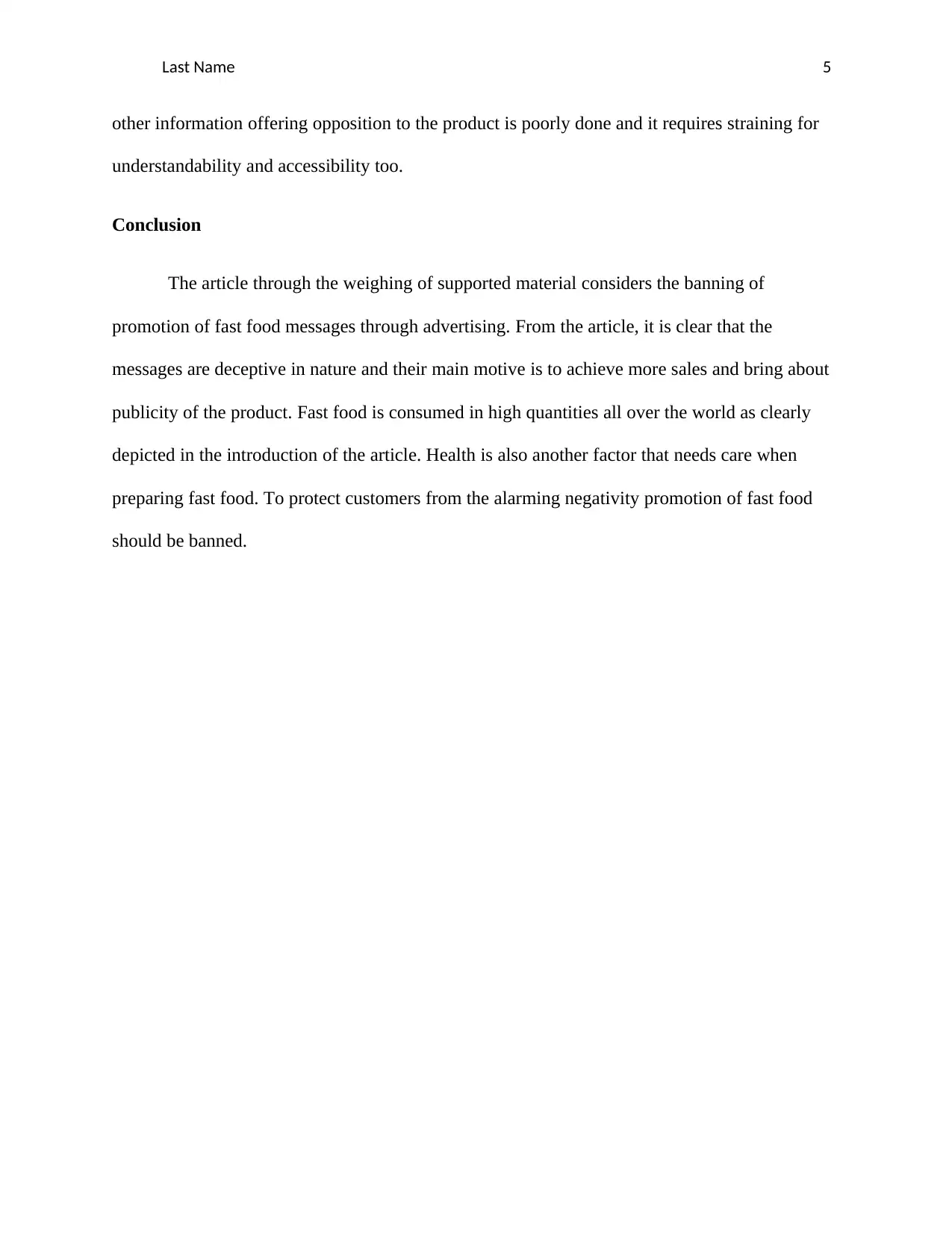
Last Name 5
other information offering opposition to the product is poorly done and it requires straining for
understandability and accessibility too.
Conclusion
The article through the weighing of supported material considers the banning of
promotion of fast food messages through advertising. From the article, it is clear that the
messages are deceptive in nature and their main motive is to achieve more sales and bring about
publicity of the product. Fast food is consumed in high quantities all over the world as clearly
depicted in the introduction of the article. Health is also another factor that needs care when
preparing fast food. To protect customers from the alarming negativity promotion of fast food
should be banned.
other information offering opposition to the product is poorly done and it requires straining for
understandability and accessibility too.
Conclusion
The article through the weighing of supported material considers the banning of
promotion of fast food messages through advertising. From the article, it is clear that the
messages are deceptive in nature and their main motive is to achieve more sales and bring about
publicity of the product. Fast food is consumed in high quantities all over the world as clearly
depicted in the introduction of the article. Health is also another factor that needs care when
preparing fast food. To protect customers from the alarming negativity promotion of fast food
should be banned.
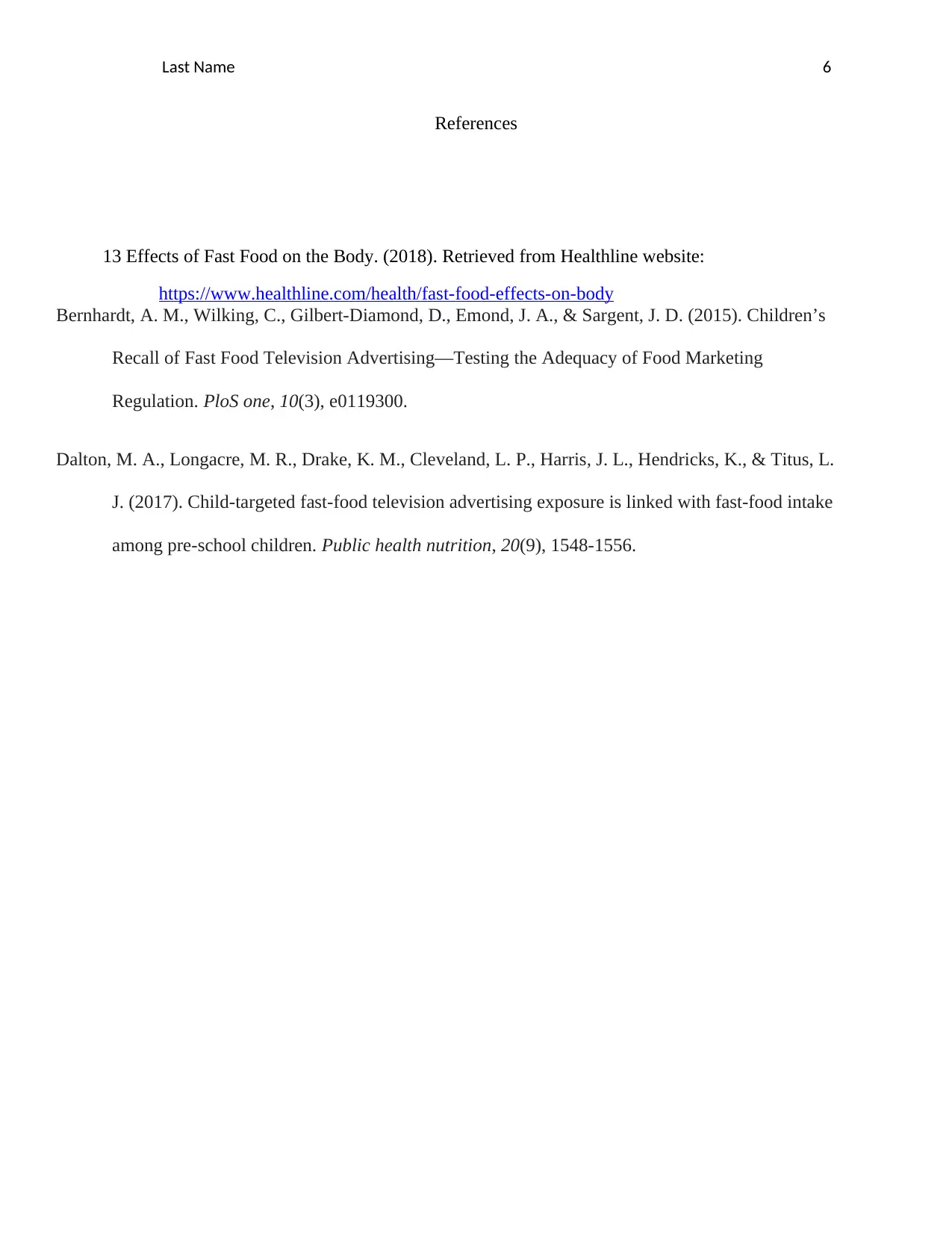
Last Name 6
References
13 Effects of Fast Food on the Body. (2018). Retrieved from Healthline website:
https://www.healthline.com/health/fast-food-effects-on-body
Bernhardt, A. M., Wilking, C., Gilbert-Diamond, D., Emond, J. A., & Sargent, J. D. (2015). Children’s
Recall of Fast Food Television Advertising—Testing the Adequacy of Food Marketing
Regulation. PloS one, 10(3), e0119300.
Dalton, M. A., Longacre, M. R., Drake, K. M., Cleveland, L. P., Harris, J. L., Hendricks, K., & Titus, L.
J. (2017). Child-targeted fast-food television advertising exposure is linked with fast-food intake
among pre-school children. Public health nutrition, 20(9), 1548-1556.
References
13 Effects of Fast Food on the Body. (2018). Retrieved from Healthline website:
https://www.healthline.com/health/fast-food-effects-on-body
Bernhardt, A. M., Wilking, C., Gilbert-Diamond, D., Emond, J. A., & Sargent, J. D. (2015). Children’s
Recall of Fast Food Television Advertising—Testing the Adequacy of Food Marketing
Regulation. PloS one, 10(3), e0119300.
Dalton, M. A., Longacre, M. R., Drake, K. M., Cleveland, L. P., Harris, J. L., Hendricks, K., & Titus, L.
J. (2017). Child-targeted fast-food television advertising exposure is linked with fast-food intake
among pre-school children. Public health nutrition, 20(9), 1548-1556.
⊘ This is a preview!⊘
Do you want full access?
Subscribe today to unlock all pages.

Trusted by 1+ million students worldwide
1 out of 6
Related Documents
Your All-in-One AI-Powered Toolkit for Academic Success.
+13062052269
info@desklib.com
Available 24*7 on WhatsApp / Email
![[object Object]](/_next/static/media/star-bottom.7253800d.svg)
Unlock your academic potential
Copyright © 2020–2025 A2Z Services. All Rights Reserved. Developed and managed by ZUCOL.





